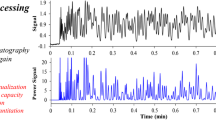Abstract
Separation techniques have developed rapidly where sub-second chromatography, ultrahigh resolution recycling chromatography, and two-dimensional liquid chromatography have become potent tools for analytical chemists. Despite the popularity of high-efficiency materials and new selectivity columns, peak overlap is still observed because as the number of analytes increases, Poisson statistics predicts a higher probability of peak overlap. This work shows the application of the properties of exponential functions and Gaussian functions for virtual resolution enhancement. A mathematical protocol is derived to recover areas from overlapping signals and overcomes the previously known limitations of power laws of losing area and height information. This method also reduces noise and makes the peaks more symmetrical while maintaining the retention time and selectivity. Furthermore, it does not require a prior knowledge of the total number of components as needed in curve fitting techniques. Complex examples are shown using chiral chromatography for enantiomers, and twin-column recycling HPLC of IgG aggregates and with tailing or fronting peaks. The strengths and weaknesses of the power law protocol for area recovery are discussed with simulated and real examples.





Similar content being viewed by others
References
Kauppinen JK, Moffatt DJ, Mantsch HH, Cameron DG (1981) Appl Spectrosc 35:271–276. https://doi.org/10.1366/0003702814732634
Ferrige A, Lindon J (1978) J Magn Reson (1969) 31:337–340
Sinanian MM, Cook DW, Rutan SC, Wijesinghe DS (2016) Anal Chem 88:11092–11099
The United States Pharmacopeia Convention (2012) “<621> Chromatography”, vol 1, USP35-NF30
Snyder LR (1970) J Chromatogr Sci 8:692–706. https://doi.org/10.1093/chromsci/8.12.692
Wahab MF, Anderson JK, Abdelrady M, Lucy CA (2014) Anal Chem 86:559–566. https://doi.org/10.1021/ac402624a
Dyson N (1998) Chromatographic Integration Methods, 2nd edn. Royal Society of Chemistry, Cornwall
Patel DC, Wahab MF, O’Haver TC, Armstrong DW (2018) Anal Chem 90:3349–3356. https://doi.org/10.1021/acs.analchem.7b04944
Wahab MF, Wimalasinghe RM, Wang Y, Barhate CL, Patel DC, Armstrong DW (2016) Anal Chem 88:8821–8826. https://doi.org/10.1021/acs.analchem.6b02260
Ciogli A, Ismail OH, Mazzoccanti G, Villani C, Gasparrini F (2018) J Sep Sci 41:1307–1318. https://doi.org/10.1002/jssc.201701406
Barhate CL, Joyce LA, Makarov AA, Zawatzky K, Bernardoni F, Schafer WA, Armstrong DW, Welch CJ, Regalado EL (2017) Chem Commun 53:509–512
Wahab MF, Patel DC, Wimalasinghe RM, Armstrong DW (2017) Anal Chem 89:8177–8191. https://doi.org/10.1021/acs.analchem.7b00931
Godinho JM, Reising AE, Tallarek U, Jorgenson JW (2016) J Chromatogr A 1462:165–169
Gritti F, Besner S, Cormier S, Gilar M (2017) J Chromatogr A 1524:108–120
Daniel E, Nicola L (2016) Chem Commun 52:13253–13256
Porath J, Flodin P (1959) Nature 183:1657–1659
Lim LW, Uzu H, Takeuchi T (2004) J Sep Sci 27:1339–1344
Davis JM, Giddings JC (1983) Anal Chem 55:418–424. https://doi.org/10.1021/ac00254a003
Shalliker RA, Stevenson PG, Shock D, Mnatsakanyan M, Dasgupta PK, Guiochon G (2010) J Chromatogr A 1217:5693–5699
Shock D, Dennis GR, Guiochon G, Dasgupta PK, Shalliker RA (2011) Anal Chim Acta 703:245–249
Dasgupta PK, Chen Y, Serrano CA, Guiochon G, Liu H, Fairchild JN, Shalliker RA (2010) Anal Chem 82:10143–10150
de Juan A, Tauler R (2006) Crit Rev Anal Chem 36:163–176
Chesler SN, Cram SP (1973) Anal Chem 45:1354–1359
Wilks DS (2011) Statistical methods in the atmospheric sciences. Academic press, Cambridge
Gritti F, Wahab MF (2018) LCGC North Am 36(2):82–98
Gritti F, Dion M, Felinger A, Savaria M (2018) J Chromatogr A 1567:164–176
Westerberg A (1969) Anal Chem 41:1770–1777
Foley JP (1987) J Chromatogr A 384:301–313
Wahab MF, Patel DC, Armstrong DW (2017) J Chromatogr A 1509:163–170. https://doi.org/10.1016/j.chroma.2017.06.031
Kalambet Y, Kozmin Y, Mikhailova K, Nagaev I, Tikhonov P (2011) J Chemom 25:352–356
Jansson PA (1984) Deconvolution with applications in spectroscopy. Academic Press, New York
Wahab MF, Dasgupta PK, Kadjo AF, Armstrong DW (2016) Anal Chim Acta 907:31–44. https://doi.org/10.1016/j.aca.2015.11.043
Weber HJ, Arfken GB (2003) Essential mathematical methods for physicists, ISE. Elsevier, New York
Author information
Authors and Affiliations
Corresponding authors
Ethics declarations
Conflict of interest
The authors declare no conflict of interest.
Ethical approval
This article does not contain any studies with human participants or animals performed by any of the authors.
Additional information
Published in Chromatographia’s 50th Anniversary Commemorative Issue.
Rights and permissions
About this article
Cite this article
Wahab, M.F., Gritti, F., O’Haver, T.C. et al. Power Law Approach as a Convenient Protocol for Improving Peak Shapes and Recovering Areas from Partially Resolved Peaks. Chromatographia 82, 211–220 (2019). https://doi.org/10.1007/s10337-018-3607-0
Received:
Revised:
Accepted:
Published:
Issue Date:
DOI: https://doi.org/10.1007/s10337-018-3607-0




